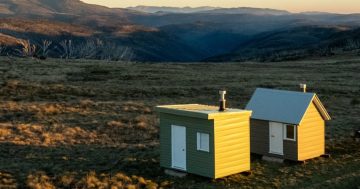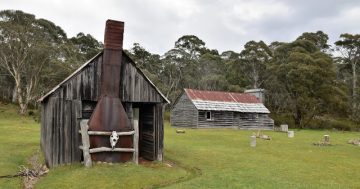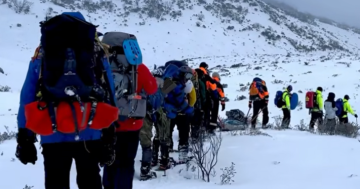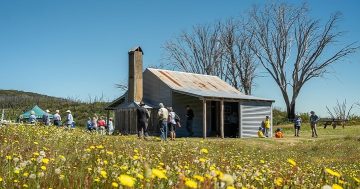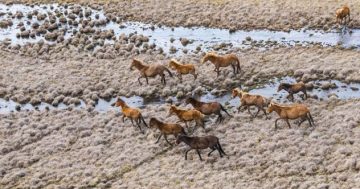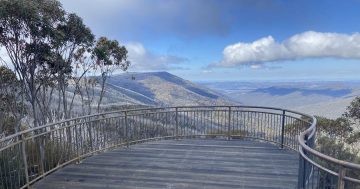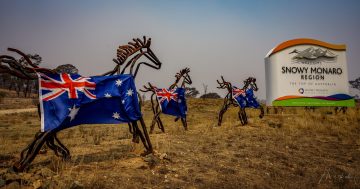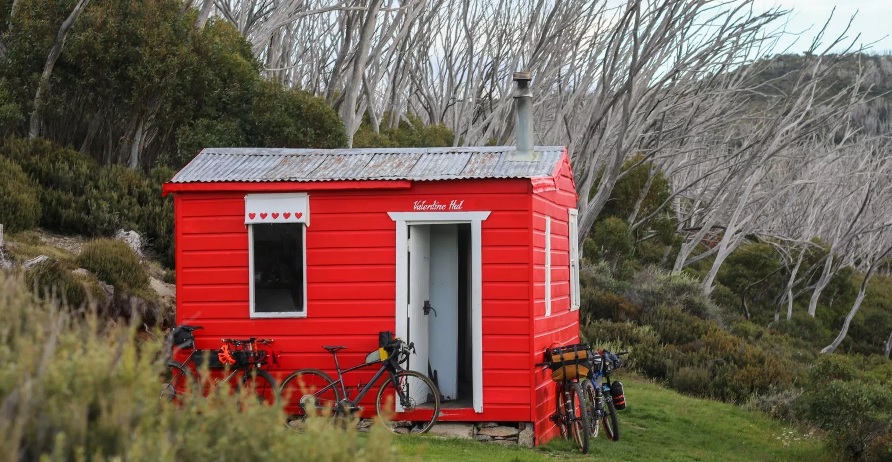
Striking red and still sprinkled with its trademark hearts, Valentine Hut in Kosciuszko National Park may have had scientific beginnings but its history of providing refuge to anyone who ventures deep into the rugged alpine wilderness endures. Photo: Desire Lines Cycling Club.
Each February, as Valentine’s Day rolls around, hearts and flowers may dominate the scene but in the Australian Alps, another kind of Valentine’s story quietly endures.
Perched deep in Kosciuszko National Park at the top of the Munyang Corridor and beneath the shadow of Mount Gungartan lies a humble red structure that tells a tale of resilience, innovation and adaptation.
Valentine Hut, with its bright red walls and a name-evoking charm, might seem like a quaint anomaly in the vast Australian Alps.
But its roots — as well as its striking silhouette against the snow — are deeply entwined with the Snowy Mountains’ turbulent history.
Valentine Hut was constructed in 1955 by the Snowy Mountains Authority (SMA) to support the ambitious Snowy Mountains Hydro-Electric Scheme.
Its name, Valentine, is a waggish nod to its original facade: painted a striking red and adorned with hearts.
This cheerful exterior belied the hut’s utilitarian purpose serving as a base for hydrologists tasked with monitoring precipitation, snow depths and stream flows on the Geehi River and its tributaries; data critical to planning the Geehi Reservoir and the Murray 1 and 2 power stations.
Though its purpose was scientific, the hut also became a lifeline in an unforgiving alpine environment.
Hydrologists, equipped with snow poles, gauging stations and even flying fox apparatus, worked year-round braving the brutal winter conditions — either skiing in or using tracked oversnow vehicles — to continue their vital work.
Measuring a mere four metres by 3.5 metres, Valentine Hut was designed for efficiency.
The structure combines timber and weatherboards, with an iron roof and wooden floors.
Two prefabricated “snow huts” served as bedrooms, flanking a central kitchen and common area with a Raeburn wood heater and steel sink. A small rear storeroom added utility.
Outside, a toilet and woodshed completed the ensemble.
Built on a bulldozed terrace — a necessity in the rugged terrain — the hut’s location was no accident. Situated near key hydrological sites, it allowed for easy access to nearby measuring stations.
The tiny building also housed SMA radio communications gear and the foundations for a tall aerial structure can still be seen on the small flat on the south side of the hut.
The radio kept the hydrologists connected to the SMA headquarters, ensuring they were never completely isolated, despite the vast wilderness surrounding them.
But the hut’s golden age of scientific endeavour was relatively short-lived.
By 1964, the gauging stations it supported had been decommissioned, and the site’s significance as a hydrological hub began to wane.
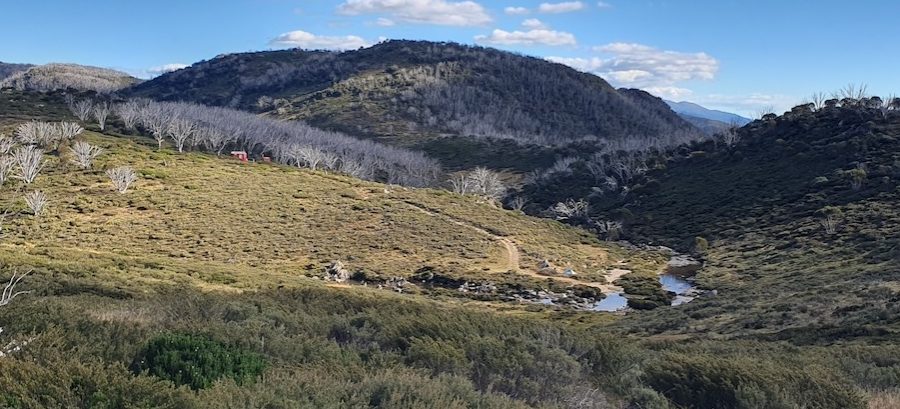
If you look hard enough you can make out the small red hut sitting atop and amid the vast alpine landscape. Photo: Kosciuszko Hut Association.
When the Exclusive Squirrels Club – consisting of six members of the Kosciusko Alpine Club who spent a week each year ski touring – visited the hut in 1967, they found it unlocked and seemingly abandoned, a relic of the past nestled in the shadow of the aptly named Ghost Mountain.
Yet, Valentine Hut did not fade into obscurity. In the 1980s, it was repurposed for recreational use, a new chapter in its evolving history.
Skiers, hikers, and adventurers embraced the hut, which was restored to its original bright red colour scheme — serving as a beacon, a waypoint and a refuge in the snow-covered landscape.
It was always the way. Stories abound of Duke of Edinburgh participants arriving at the hut cold and unprepared, only to be met with the kindness of hydrologists offering tea and provisions.
Over the years, Valentine Hut has seen multiple renovations, each preserving its character while adapting it for modern needs. The original stove was replaced, bunk beds installed, and the shed removed. The toilet, once celebrated for its unparalleled mountain views, was upgraded to a pump-out system.
Most notably, in 2016, the NSW National Parks and Wildlife Service (NPWS) undertook significant reconstruction, installing a steel subframe to ensure the hut’s longevity.
But Valentine Hut is more than just a physical structure; it’s a symbol of the region’s transformation.
From the mid-19th century, when pastoralists grazed sheep and cattle on the high plains, to the construction of the Snowy Mountains Hydro-Electric Scheme, the area has seen waves of human endeavour and environmental change.
Archibald Rial, John Coughlan and David McPhie, among others, left their mark through grazing leases of which there now is little trace.
And there remains the perennial quest to find evidence of the old stockman’s hut that once stood nearby.
The small and crude structure was said to have been a ruin of the cessation of grazing above 4500 feet in 1954.
Arthur Harris, a stockman at Mawson’s Hut, once divulged the shepherd who occupied that hut was known locally as “Fleecy-lined Underpants”.
Valentine Hut has weathered decades of change, serving diverse purposes — scientific, recreational and cultural.
Its vivid red walls and sturdy frame continue to welcome visitors, offering a glimpse into the rich history of the Snowy Mountains.
For those who find themselves atop the Munyang Corridor, Valentine Hut is more than a shelter – it’s a living piece of history, quietly bridging the past and present, one snow-covered season at a time.
With enormous thanks to the Kosciuszko Huts Association.
Original Article published by Edwina Mason on About Regional.







